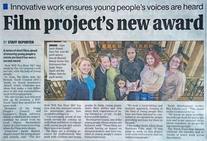The extinction of the Youth Service: the undervaluing of youth space
2018-03-06
This blog as written by Brahmpreet Gulati, a Member of the Youth Parliament and a youth councillor for  Thurnby Lodge, who attended Raven Youth Centre in Leicester. Brahmpreet was part of the 'How Will You Hear Me?' project where young people shared their personal stories and talked about their experiences of being listened to – or not – by different public bodies across a series of short films.
Thurnby Lodge, who attended Raven Youth Centre in Leicester. Brahmpreet was part of the 'How Will You Hear Me?' project where young people shared their personal stories and talked about their experiences of being listened to – or not – by different public bodies across a series of short films.
It is a common view among our society that youth centres are old-fashioned buildings with some snooker tables and sofa’s lying around. This is the perspective that most adults, and most politicians take, however it is not the view of the young people who actually use these spaces. For them it’s a place where bantering and opening-up about the deepest fears is acceptable, a place where meeting your friends is not seen as a threat by the outside world, and most importantly a place where two generations meet and can have a conversation without awkwardness.
Leicester City is one of the local authorities who had drastic cuts made to the youth services they provide. Many young people were engaged in the City’s consultation process used for these cuts, for example through the Young People's Council attending scrutiny meetings and meeting with the Assistant Mayor, to ensure that young people’s voices are heard and acted upon. These examples show that they’ are effective mechanisms available for local authorities to work in partnership with young people, however this does not always take place.
Many local authorities across the country are beginning to take control of this space, and the voices of the young people affected are ignored as budgets are cut with little care for the impact on the futures of the people affected. Massive changes of youth workers and provision means that the environment in youth centres that‘s crucial for young people changes. Distress replaces the cohesiveness of the same youth centre - as changes in timing and staffing replace that warm comfort of the centre. Young people already face lots of ongoing battles, whether that’s looking after an ill parent or family member, or being vulnerable to online trolls. When making these cuts, the authorities fail to recognise that they’re creating an additional battle for these young people, they now have to fight for a youth club, a designated space, for a place to escape! This goes against the common message to young people that it’s “their” youth club.
Closing one youth centre may not seem like much of an immediate loss, however individual youth clubs are a part of larger whole, and when all the losses are added up society becomes increasingly fragmented. Anyone who thinks that this can simply be filled by schools is missing that the relationship between a teacher and young person could never compare or compete between a youth worker and a young person. The classroom setting for many young people is a setting of listening and learning in order to pass exams, rather than a platform to let loose and explore other areas of life.
With the positive effects of good youth services often only clear in the future, youth clubs have become too easy a place to cut. Unfortunately, once the space is lost it’s lost. I can’t help but think that there will be a time when the next generation of decision makers question the burden among the remaining services, which will have to face the increased pressures created from a loss of youth clubs, and realise that the cut youth services a crucial missing piece in the puzzle.
